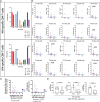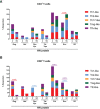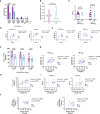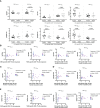T-Follicular-Like CD8+ T Cell Responses in Chronic HIV Infection Are Associated With Virus Control and Antibody Isotype Switching to IgG
- PMID: 35784304
- PMCID: PMC9241491
- DOI: 10.3389/fimmu.2022.928039
T-Follicular-Like CD8+ T Cell Responses in Chronic HIV Infection Are Associated With Virus Control and Antibody Isotype Switching to IgG
Abstract
T cell responses are considered critical for the in vivo control of HIV, but the contribution of different T cell subsets to this control remains unclear. Using a boosted flow cytometric approach that is able to differentiate CD4+ and CD8+ T cell Th1/Tc1, Th2/Tc2, Th17/Tc17, Treg and Tfh/Tfc-like HIV-specific T cell populations, we identified CD8+ Tfc responses that were related to HIV plasma viral loads and associated with rate of antibody isotype class switching to IgG. This favorable balance towards IgG responses positively correlated with increased virus neutralization, higher avidity of neutralizing antibodies and more potent antibody-dependent cell cytotoxicity (ADCC) in PBMCs from HIV controllers compared to non-controllers. Our results identified the CD8+ Tfc-like T-cell response as a component of effective virus control which could possibly be exploited therapeutically.
Keywords: HIV; T-follicular cytotoxic (Tfc) cells; human immunodeficiency virus (HIV) control; humoral immune response; viral control.
Copyright © 2022 Romero-Martín, Tarrés-Freixas, Pedreño-López, de la Concepción, Cunyat, Hartigan-O'Connor, Carrillo, Mothe, Blanco, Ruiz-Riol, Brander and Olvera.
Conflict of interest statement
Author CB was employed by company AELIX Therapeutics. MR-R and CB are co-inventors of the “Boosted flow” technology, which is protected under patent application US9709577B2. The remaining authors declare that the research was conducted in the absence of any commercial or financial relationships that could be construed as a potential conflict of interest.
Figures








Similar articles
-
Resolution of hepatitis E virus infection in CD8+ T cell-depleted rhesus macaques.J Hepatol. 2021 Sep;75(3):557-564. doi: 10.1016/j.jhep.2021.04.036. Epub 2021 May 4. J Hepatol. 2021. PMID: 33961939 Free PMC article.
-
Structured treatment interruptions (STI) in chronic unsuppressed HIV infection in adults.Cochrane Database Syst Rev. 2006 Jul 19;2006(3):CD006148. doi: 10.1002/14651858.CD006148. Cochrane Database Syst Rev. 2006. PMID: 16856117 Free PMC article.
-
Comprehensive single-cell chromatin and transcriptomic profiling of peripheral immune cells in nonsegmental vitiligo.Br J Dermatol. 2025 Jun 20;193(1):115-124. doi: 10.1093/bjd/ljaf041. Br J Dermatol. 2025. PMID: 39888372
-
Antibody tests for identification of current and past infection with SARS-CoV-2.Cochrane Database Syst Rev. 2022 Nov 17;11(11):CD013652. doi: 10.1002/14651858.CD013652.pub2. Cochrane Database Syst Rev. 2022. PMID: 36394900 Free PMC article.
-
Human Immunodeficiency Virus-Human Pegivirus Coinfected Individuals Display Functional Mucosal-Associated Invariant T Cells and Follicular T Cells Irrespective of PD-1 Expression.Viral Immunol. 2024 Jun;37(5):240-250. doi: 10.1089/vim.2024.0007. Epub 2024 May 29. Viral Immunol. 2024. PMID: 38808464 Free PMC article.
Cited by
-
HIV T-cell immunogen design and delivery.Curr Opin HIV AIDS. 2022 Nov 1;17(6):333-337. doi: 10.1097/COH.0000000000000765. Epub 2022 Sep 19. Curr Opin HIV AIDS. 2022. PMID: 36165078 Free PMC article. Review.
-
Computational and Population-Based HLA Permissiveness to HIV Drug Resistance-Associated Mutations.Pathogens. 2025 Feb 20;14(3):207. doi: 10.3390/pathogens14030207. Pathogens. 2025. PMID: 40137693 Free PMC article.
-
Prospects for therapeutic T-cell vaccine strategies for HIV cure.Curr Opin HIV AIDS. 2025 Sep 1;20(5):463-471. doi: 10.1097/COH.0000000000000965. Epub 2025 Jul 9. Curr Opin HIV AIDS. 2025. PMID: 40638102 Free PMC article. Review.
-
The Complex Role of CD8+ T Cells in Placental HIV Infection.Eur J Immunol. 2025 Jun;55(6):e51615. doi: 10.1002/eji.202451615. Eur J Immunol. 2025. PMID: 40498383 Free PMC article. Review.
References
Publication types
MeSH terms
Substances
Grants and funding
LinkOut - more resources
Full Text Sources
Other Literature Sources
Medical
Research Materials

